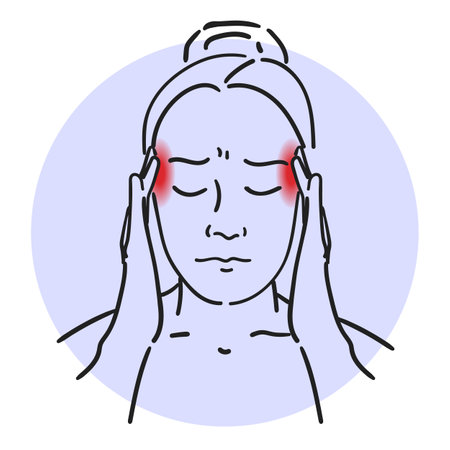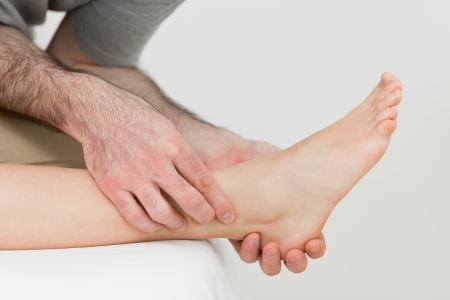Understanding Nerve Pain: Causes and Symptoms
Nerve pain, also known as neuropathic pain, is a common problem many Americans face. It can feel sharp, burning, tingling, or even like electric shocks. This kind of pain happens when nerves in your body are damaged or irritated. Let’s take a closer look at the causes and symptoms so you can better understand what might be going on.
Common Causes of Nerve Pain
| Cause | Description | Common in the U.S.? |
|---|---|---|
| Sciatica | Pain caused by pressure or irritation of the sciatic nerve, often from a herniated disc or spinal stenosis | Yes, especially in adults with back problems or sedentary lifestyles |
| Peripheral Neuropathy | Nerve damage most often due to diabetes, chemotherapy, infections, or alcoholism | Very common, especially among people with diabetes |
| Carpal Tunnel Syndrome | Compression of the median nerve in the wrist, often related to repetitive hand movements or computer use | Common among office workers and manual laborers |
| Postherpetic Neuralgia | Nerve pain after a shingles outbreak (caused by the chickenpox virus) | Seen more frequently in older adults |
| Trauma/Injury | Nerve damage from accidents, surgeries, or injuries that impact nerves directly | Occurs across all age groups following accidents or sports injuries |
How Symptoms Show Up in Everyday Life
Nerve pain can affect people differently, but here are some ways it might show up for American patients:
- Burning Sensation: Many describe their pain as a hot or “on fire” feeling.
- Tingling and Numbness: Like pins and needles, especially in hands, feet, arms, or legs.
- Shooting Pain: Sudden jolts that can make it hard to walk or sit comfortably.
- Muscle Weakness: Some may find it difficult to grip objects or maintain balance.
- Sensitivity to Touch: Even light touches (like clothing) can hurt.
- Pain That Gets Worse at Night: Many find nerve pain intensifies when they’re trying to rest.
Sciatica vs. Peripheral Neuropathy: Quick Comparison for Patients
| Sciatica | Peripheral Neuropathy | |
|---|---|---|
| Main Location of Pain | Lower back radiating down one leg | Hands and feet (can spread up limbs) |
| Main Cause in U.S. | Herniated discs, spinal stenosis, injury from lifting heavy objects | Diabetes, chemo side effects, alcohol abuse, infections |
| Pain Quality | Shooting, burning, numbness in one leg/side of body | Tingling, numbness, burning in both hands/feet (often symmetrical) |
| Affected Age Group | Mainly adults 30-60 years old | Mainly older adults; those with chronic health issues |
The Takeaway: Spotting Nerve Pain Early Helps Recovery
If you notice these symptoms—especially if you have a condition like diabetes or recent back injury—it’s important to talk with your healthcare provider early. Catching nerve pain signs quickly can help guide you toward effective physical therapy interventions tailored just for you.
Role of Physical Therapy in Nerve Pain Management
Physical therapy (PT) plays a vital role in managing nerve pain, such as sciatica and neuropathy, across the United States. For many people dealing with these conditions, PT is often one of the first treatments doctors recommend. It’s not just about easing pain—it also helps restore function, improve mobility, and prevent further complications.
How Physical Therapy Helps with Nerve Pain
Nerve pain can be stubborn and may interfere with daily life. Physical therapists use a range of techniques to address the root causes and symptoms of nerve pain. Here’s how PT is commonly used:
| PT Technique | Description | Common Uses |
|---|---|---|
| Manual Therapy | Hands-on techniques to mobilize joints and soft tissues | Sciatica, pinched nerves |
| Therapeutic Exercises | Targeted movements to strengthen muscles and improve flexibility | Neuropathy, post-surgical recovery |
| Neuromuscular Re-Education | Exercises to retrain nerve-muscle connections | Nerve injuries, diabetic neuropathy |
| Pain Relief Modalities | Treatments like heat, ice, ultrasound, or electrical stimulation (TENS) | Acute or chronic nerve pain flare-ups |
| Patient Education & Ergonomics | Teaching safe movement patterns and lifestyle adjustments | Prevention and self-management for all types of nerve pain |
The Importance of PT in U.S. Healthcare Settings
In the U.S., physical therapy is recognized as a cornerstone treatment for nerve pain by healthcare providers. Insurance plans often cover PT because it reduces the need for medications or surgery. By focusing on conservative care first, patients can avoid side effects from long-term drug use or the risks that come with surgical procedures.
Benefits for Patients Across America
- Personalized Care: Treatment plans are tailored to each person’s needs and lifestyle.
- Team Approach: Physical therapists work closely with doctors, nurses, and other specialists.
- Empowerment: Patients learn exercises and strategies they can use at home.
- Accessibility: PT clinics are found in most communities—from big cities to rural towns.
- Cultural Sensitivity: Therapists consider cultural preferences and language needs during care.
A Day in Physical Therapy for Nerve Pain Patients
A typical session might include guided stretches, strength-building exercises, hands-on therapy, and advice on posture or daily activities. Many Americans appreciate how PT sessions can fit into their regular routines—whether before work or after school drop-off—making it easier to stay committed to their recovery plan.

3. Physical Therapy Interventions for Sciatica and Neuropathy
Understanding the Approach
Physical therapy is a cornerstone for managing nerve pain, especially conditions like sciatica and diabetic neuropathy. The treatment plan is always personalized, taking into account each patients symptoms and lifestyle. In the U.S., physical therapists focus on helping people return to work, daily activities, and hobbies with less pain and more confidence.
Manual Therapy Techniques
Manual therapy involves hands-on techniques that help reduce pain and improve mobility. Here are some common methods used:
| Technique | Description | When Its Used |
|---|---|---|
| Soft Tissue Mobilization | Massage or gentle pressure to relax tight muscles and decrease inflammation around nerves. | Sciatica, neuropathy with muscle tightness |
| Nerve Gliding Exercises | Special movements that help nerves move freely through tissues, reducing irritation and pain. | Sciatica, carpal tunnel syndrome, diabetic neuropathy |
| Joint Mobilization | Gentle movement of joints to improve flexibility and decrease stiffness. | Sciatica with lower back or hip involvement |
Therapeutic Exercise Programs
Exercise is essential for both recovery and prevention. Physical therapists design specific routines based on your needs:
- Stretching: Eases tension in muscles that may put pressure on nerves (e.g., hamstring stretches for sciatica).
- Strengthening: Focuses on core, back, or leg muscles to better support your body and protect nerves.
- Aerobic Activity: Gentle walking or cycling improves blood flow, which can help nerve healing—especially important in diabetic neuropathy.
- Balance and Coordination: For those with numbness or weakness, balance training reduces fall risk.
Sample Exercise Table for Sciatica and Neuropathy
| Exercise Name | Main Benefit | Sciatica/Neuropathy? |
|---|---|---|
| Piriformis Stretch | Reduces pressure on sciatic nerve | Sciatica |
| Ankle Pumps | Improves circulation in feet/legs | Neuropathy |
| Pelvic Tilts | Strengthens low back/core muscles | Sciatica & Neuropathy |
| Tandem Walking (heel-to-toe) | Enhances balance/stability | Neuropathy (fall prevention) |
Treatment Modalities: Tools for Pain Relief and Healing
Physical therapists use various tools (modalities) to further reduce nerve pain:
- TENS (Transcutaneous Electrical Nerve Stimulation): Sends mild electrical currents through the skin to disrupt pain signals—often used at home between PT visits.
- Heat/Cold Therapy: Applying heat can relax tight muscles; cold packs help reduce swelling and numb sharp pain.
- Ultrasound Therapy: Uses sound waves to promote tissue healing and blood flow in deep tissues—sometimes helpful for chronic nerve pain.
Your Individual Plan Matters Most
No two cases of sciatica or neuropathy are exactly alike. A licensed physical therapist will assess your symptoms, goals, and daily routine to build a plan just for you—helping you get back to living life on your terms.
4. Personalizing Treatment: Patient-Centered Approaches
Physical therapists (PTs) in the United States understand that every person experiences nerve pain differently. Sciatica, neuropathy, and other nerve-related conditions can be influenced by your daily activities, job requirements, family responsibilities, and even your cultural background. That’s why PTs focus on creating individualized care plans to make sure each patient gets the best possible support for their unique situation.
How PTs Customize Care for Nerve Pain
Instead of using a one-size-fits-all approach, PTs take time to get to know you—your lifestyle, what you do for work, and what matters most to you. Here’s how they usually personalize your treatment plan:
| Consideration | What PTs Do | Examples in Practice |
|---|---|---|
| Lifestyle | Ask about daily routines, hobbies, and activity levels | If you love hiking, exercises may include walking or balance training outdoors |
| Work Habits | Assess job demands—sitting, standing, lifting, or repetitive motions | If you sit at a desk all day, they may teach stretches or ergonomic tips for office work |
| Cultural Preferences | Respect beliefs and customs related to health care and physical touch | If you prefer female providers or want family involved in sessions, PTs will accommodate when possible |
Why Personalization Matters for Nerve Pain
Nerve pain like sciatica or neuropathy can affect everything from mobility to sleep. By tailoring treatment plans to your real-life needs, PTs help you stick with therapy and see better results. For example:
- Pain Management Techniques: Some patients benefit from gentle stretches and heat therapy at home; others may need hands-on manual therapy or electrical stimulation during clinic visits.
- Education: PTs teach strategies to avoid nerve aggravation during everyday tasks—like proper body mechanics while lifting kids or groceries.
- Goal Setting: Your goals might be returning to work comfortably, playing sports again, or simply sleeping through the night without pain.
Sample Patient Profiles and Adapted Interventions
| Patient Profile | Main Concerns | Customized Intervention Example |
|---|---|---|
| Office Worker with Sciatica | Sitting pain, limited flexibility | Posture training, seated stretches, ergonomic workstation adjustments |
| Construction Worker with Neuropathy | Numbness in feet, balance issues on uneven ground | Balance exercises, safety education for job site navigation, foot care advice |
| Retired Grandparent with Chronic Nerve Pain | Trouble walking grandkids to school safely due to leg weakness | Strengthening routines at home, walking aids if needed, family involvement in sessions for support |
The Role of Communication and Trust
Your input is essential! U.S.-based PTs encourage open conversations about your progress and comfort level with each step of your personalized plan. If something isn’t working or feels uncomfortable due to cultural reasons or personal beliefs, don’t hesitate to speak up—your feedback helps guide your care journey.
5. Prevention, Education, and At-Home Strategies
Tips for Ongoing Management of Nerve Pain
Nerve pain like sciatica or neuropathy can be tough to manage, but there are many simple ways to help prevent flare-ups and make daily life easier. Physical therapists often recommend combining clinic visits with practical steps at home and work. Here are some friendly tips you can try:
Self-Care Education for Everyday Life
- Stay Active: Gentle movement like walking, stretching, or yoga keeps nerves healthy. Even short walks around your neighborhood or local park can make a difference.
- Practice Good Posture: Whether sitting at your desk or standing in the kitchen, keep your back straight and shoulders relaxed to reduce nerve pressure.
- Mindful Lifting: Always bend at the knees and hold objects close to your body when lifting anything heavy—whether it’s groceries or a laundry basket.
- Pain Management: Use ice packs or heating pads as recommended by your therapist. Over-the-counter pain creams might also help soothe sore spots.
- Daily Foot Checks: If you have neuropathy, check your feet each day for cuts or blisters, especially if you have diabetes.
Ergonomic Advice for American Work and Home Settings
The right setup at work and home can protect your nerves from unnecessary stress. Here’s a table with quick ergonomic adjustments you can use:
| Location | Simple Ergonomic Tip |
|---|---|
| Home Office/Work Desk | Use a chair with lumbar support; keep monitor at eye level; take stretch breaks every 30–60 minutes |
| Kitchen | Place frequently used items within easy reach; use anti-fatigue mats if standing for long periods |
| Living Room/TV Area | Sit with feet flat on the floor; avoid slouching on soft couches; use small cushions for back support |
| Car/Commuting | Adjust seat so knees are level with hips; use a rolled towel behind the lower back for extra support |
| Bedroom | Select a mattress that supports spinal alignment; use pillows to keep hips and knees comfortable when sleeping on your side |
Other Helpful Habits for Long-Term Relief
- Create a Daily Routine: Consistency is key—set reminders to stretch, move, and check your posture throughout the day.
- Wear Supportive Shoes: Choose shoes with cushioning and arch support, especially if you’re on your feet all day.
- Avoid Prolonged Sitting: Stand up and move every hour—even a few minutes helps keep nerves happy.
- Tune Into Your Body: If an activity makes pain worse, adjust how you do it or take more frequent breaks.
- Stay Connected with Your Physical Therapist: Regular check-ins can help catch issues early and keep you on track with your progress.
Your Next Steps: Small Changes Add Up!
You don’t have to overhaul your whole lifestyle overnight. Start with one or two changes that fit into your routine. Over time, these prevention strategies can make managing nerve pain much more doable—right in the comfort of your own home or workplace.


